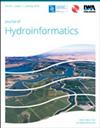Large-eddy simulation of free-surface turbulent flow in a non-prismatic channel
IF 2.2
3区 工程技术
Q3 COMPUTER SCIENCE, INTERDISCIPLINARY APPLICATIONS
引用次数: 0
Abstract
Hydraulic engineering applications require a good knowledge of turbulent behaviour in non-prismatic channels. This paper aims to predict turbulent behaviour using the large-eddy simulation (LES) method. The model channel has a warped transition. We perform two-phase LES of free-surface flow and validate the results using experimental data and benchmark solution. We discuss rigorous strategies for model set-up, parameter selection and parametric value assignment, including parameters in the spectrum synthesiser (SS) and vortex method (VM) for inlet turbulence. The predicted flow displays complex structures due to eddy motions translated from upstream and locally generated by asymmetrical separation in the transition. The history of the flow dynamics may affect the flow development. The predicted velocity, energy spectrum, root-mean-square error, hit-rate and factor-of-two compare well with measurements and benchmark solution. Mapping mean-velocity distribution from experimental data, combined with SS, gives satisfactory inlet condition; alternatively, a 1/7th power-law for the mean-velocity, combined with VM, is acceptable. This paper uses the Okubo–Weiss parameter to delineate 3D instantaneous coherent structures. The LES methods are reliable, efficient and cost-effective. As compared to the simulation of prismatic channels, the flow dynamics in non-prismatic channels exhibit flow separation and turbulence interactions, which increase the flow-complexity, while offering results with crucial practical applications.非棱柱形通道中自由表面湍流的大涡模拟
水利工程应用需要对非棱柱形通道中的湍流行为有很好的了解。本文旨在利用大涡模拟(LES)方法预测湍流行为。模型通道有一个扭曲的过渡。我们进行了自由表面流动的两相LES,并使用实验数据和基准解决方案验证了结果。我们讨论了模型建立、参数选择和参数值分配的严格策略,包括频谱合成器(SS)和涡旋方法(VM)中的参数。由于上游的涡流运动和过渡段的不对称分离在局部产生的涡流运动,预测的流动呈现复杂的结构。流动动力学的历史可能影响流动的发展。预测的速度、能谱、均方根误差、命中率和二系数与测量结果和基准解决方案比较良好。利用实验数据映射平均速度分布,结合SS,得到了满意的入口条件;或者,平均速度的1/7幂律,结合VM,是可以接受的。本文采用Okubo-Weiss参数来描述三维瞬态相干结构。LES方法可靠、高效、经济。与棱柱形通道的模拟相比,非棱柱形通道中的流动动力学表现出流动分离和湍流相互作用,这增加了流动的复杂性,同时提供了具有重要实际应用价值的结果。
本文章由计算机程序翻译,如有差异,请以英文原文为准。
求助全文
约1分钟内获得全文
求助全文
来源期刊

Journal of Hydroinformatics
工程技术-工程:土木
CiteScore
4.80
自引率
3.70%
发文量
59
审稿时长
3 months
期刊介绍:
Journal of Hydroinformatics is a peer-reviewed journal devoted to the application of information technology in the widest sense to problems of the aquatic environment. It promotes Hydroinformatics as a cross-disciplinary field of study, combining technological, human-sociological and more general environmental interests, including an ethical perspective.
 求助内容:
求助内容: 应助结果提醒方式:
应助结果提醒方式:


